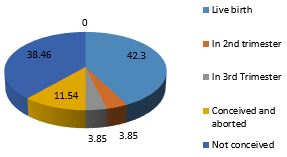Effect of Ayurvedic Treatment Modalities on Recurrent Pregnancy Loss
DOI:
https://doi.org/10.21760/jaims.7.10.3Keywords:
Recurrent pregnancy Loss, Puthraghni Yonivyapath, Garbhasravivandhya, Shonita Dusti, Artava DustiAbstract
Recurrent pregnancy Loss is defined as the sequence of 2 or more spontaneous abortions as documented by either sonography or on histopathology before 20 weeks. It is a relatively common event, occurring in 15%-25% of pregnancies, and increasing in prevalence with maternal age. The causes of recurrent abortion are complex & obscure. More than one factor may operate in a case. Identification and treatment of problems significantly increases the successful outcome in most cases. Recurrent pregnancy loss can be correlated with Puthraghni Yonivyapath and Garbhasravivandhya explained in Ayurvedic classics. Puthraghni is a clinical entity characterised by repeated pregnancy loss due to excessive intake of Rooksha Ahara and Vihara which results in repeated pregnancy losses. Ayurveda advises to do Shodhana Karma or purificatory therapies ending with Uttara Vasthi in recurrent losses. The study design was Prospective single arm interventional study conducted in the OPD and IPD of Govt. Ayurveda college hospital for Women and Children, Poojapura, Thiruvananthapuram with the study population of females of age group 20-38, diagnosed with RPL. IP management was done for 1 month followed by internal administration of Phala Sarpis as Vicharana Snehapana 10ml twice daily morning and evening ½ hour before food and Vilwadi Gulika 1 tab twice daily after food was also given for 2 months. After 15 months after the follow up period, Statistical analysis was done and Percentage of live births was assessed. Even though percentage of live births is 42.3, the success rate can be considered as 46.15% as the 1 patient to be delivered has completed 34 weeks of gestation and successfully continuing the pregnancy.
Downloads
References
D C Dutta’s Textbook of Gynaecology Edited by Hiralal Konar, 7th edition, page 186-192
Ford HB, Schust DJ. Recurrent pregnancy loss: etiology, diagnosis, and therapy. Rev Obstet Gynecol. 2009 Spring;2(2):76-83. PMID: 19609401; PMCID: PMC2709325.
Srikanthamurthy K. R., Sushruta samhita, edition 2004, Chaukhamba orientalia Varanasi, Utharathantra, Chapter 38, versus 13-14
Pillarisetty LS, Mahdy H. Recurrent Pregnancy Loss. 2022 May 8. In: StatPearls [Internet]. Treasure Island (FL): StatPearls Publishing; 2022 Jan–. PMID: 32119347.
Ram Karan Sharma, Vaidya Bhagwan Dash. Charaka Samhita Chikitsa Sthana, Vol. 4, Varanasi: Chowkhamba Sanskrit series office; 2013, Chapter 30, sloka.125
Prof.P.V.Tewari, Kashyapa Samhita,Chaukambha Viswabharati, Varanasi, Sidhi sthana Chapter 2, sloka 13
Prof.P.V.Tewari, Kashyapa Samhita, Chaukambha Viswabharati, Varanasi, Sidhi sthana Chapter 1, sloka 39,41















